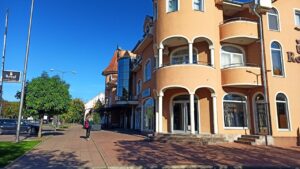Automation and technology in residential complexes of Subotica
In recent years, the city of Subotica has witnessed a significant transformation in its residential complexes, driven by advancements in automation and technology. As urban living continues to evolve, the integration of smart technologies into residential environments has become a focal point for developers and residents alike. This article explores the various aspects of automation and technology in Subotica’s residential complexes, highlighting their benefits, challenges, and future prospects.
Automation and Technology in Residential Complexes of Subotica
The integration of automation in residential complexes in Subotica has revolutionized the way residents interact with their living spaces. Smart home technologies, such as automated lighting, climate control, and security systems, have become increasingly prevalent. These systems not only enhance convenience but also contribute to energy efficiency, allowing residents to monitor and control their energy consumption remotely. For instance, smart thermostats can learn a household’s schedule and adjust heating and cooling accordingly, leading to significant savings on utility bills.
Moreover, the implementation of advanced security systems has become a priority for many residential complexes. Features such as video surveillance, smart locks, and intercom systems provide residents with peace of mind and enhanced safety. In Subotica, many new developments are incorporating these technologies as standard, ensuring that residents can feel secure in their homes. Additionally, the use of mobile applications for access control and visitor management has streamlined the process of managing entry to buildings, making it more efficient and user-friendly.
However, the adoption of automation and technology in residential complexes is not without its challenges. One of the primary concerns is the digital divide, as not all residents may have the same level of access to technology or the internet. This disparity can lead to unequal benefits among residents, particularly in older complexes where infrastructure may not support advanced technologies. Furthermore, the initial investment required for implementing these systems can be a barrier for some developers, especially in a market where affordability is a key consideration for potential buyers.
Benefits of Automation and Technology
The benefits of automation and technology in Subotica’s residential complexes extend beyond mere convenience. One of the most significant advantages is the potential for improved energy efficiency. By utilizing smart technologies, residents can optimize their energy use, reducing their carbon footprint and contributing to a more sustainable urban environment. For example, smart lighting systems can automatically adjust based on natural light levels, ensuring that energy is not wasted when it is not needed.
Additionally, the integration of technology can enhance the overall quality of life for residents. Smart home devices can facilitate a more comfortable living environment, allowing individuals to customize their settings according to personal preferences. Features such as automated blinds, smart appliances, and voice-activated assistants can create a seamless living experience, making daily tasks more manageable and enjoyable. This level of personalization is particularly appealing to younger generations who prioritize technology in their living spaces.
Furthermore, the community aspect of residential complexes can be enriched through technology. Many developments in Subotica are incorporating communal platforms that allow residents to connect, share resources, and organize events. These platforms can foster a sense of community and belonging, which is essential in urban living. By leveraging technology, residents can engage with their neighbors, participate in community initiatives, and enhance their overall living experience.
Challenges and Considerations
Despite the numerous benefits, the implementation of automation and technology in residential complexes in Subotica faces several challenges that must be addressed. One major concern is the issue of data privacy and security. As more devices become interconnected, the risk of cyber threats increases. Residents must be assured that their personal information is protected and that the systems in place are secure from potential breaches. Developers and property managers must prioritize cybersecurity measures to safeguard residents’ data.
Another challenge is the need for ongoing maintenance and support for these technologies. As systems become more complex, the requirement for technical expertise increases. Property management teams must be equipped to handle troubleshooting and maintenance, ensuring that residents can fully benefit from the technologies in place. This may necessitate additional training and resources, which can be a financial burden for some complexes.
Lastly, the rapid pace of technological advancement poses a challenge for residential complexes. As new technologies emerge, older systems may quickly become obsolete, leading to potential dissatisfaction among residents. Developers must strike a balance between investing in cutting-edge technologies and ensuring that they remain relevant and functional over time. This requires careful planning and consideration of long-term sustainability in the design and implementation of automated systems.
In conclusion, the integration of automation and technology in the residential complexes of Subotica presents both opportunities and challenges. While these advancements offer numerous benefits, including enhanced convenience, energy efficiency, and improved quality of life, they also raise important considerations regarding data security, maintenance, and the potential for inequality among residents. As Subotica continues to develop, it will be crucial for stakeholders to address these challenges proactively, ensuring that the benefits of technology are accessible to all residents and contribute to a sustainable and vibrant urban community.


